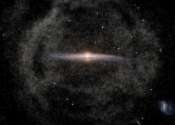Monthly Notices of the Royal Astronomical Society (MNRAS) is one of the world s leading scientific journals in astronomy and astrophysics. It has been in continuous existence since 1827 and publishes peer-reviewed letters and papers reporting original research in relevant fields. Despite the name, the journal is no longer monthly nor does it carry the notices of the Royal Astronomical Society.
The first issue of MNRAS was published on 9 February 1827 as Monthly Notices of the Astronomical Society of London and it has been in continuous publication ever since. It took its current name from the second volume, after the Astronomical Society of London became the Royal Astronomical Society (RAS). Until 1960 it carried the monthly notices of the RAS, at which time these were transferred to the newly-established Quarterly Journal of the Royal Astronomical Society (1960–1996) and then to its successor journal Astronomy & Geophysics (since 1997). Until 1965, MNRAS was published in-house by the RAS; since then, it has been published by Blackwell Scientific Publications (later Wiley-Blackwell) on behalf of the RAS.
As well, the journal is no longer monthly, with thirty-six issues a year
- Publisher
- Wiley-Blackwell (publisher) Wiley-Blackwell for the Royal Astronomical Society
- Country
- United Kingdom
- History
- 1827–present
- Website
- http://www.wiley.com/bw/journal.asp?ref=0035-8711
- Impact factor
-
5.185
(5.185)
Some content from Wikipedia,
licensed under CC BY-SA









